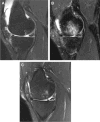MR imaging assessment of articular cartilage repair procedures
- PMID: 21665093
- PMCID: PMC3764996
- DOI: 10.1016/j.mric.2011.02.002
MR imaging assessment of articular cartilage repair procedures
Abstract
Because articular cartilage is avascular and has no intrinsic capacity to heal itself, physical damage to cartilage poses a serious clinical problem for orthopedic surgeons and rheumatologists. No medication exists to treat or reconstitute physical defects in articular cartilage, and pharmacotherapy is limited to pain control. Developments in the field of articular cartilage repair include microfracture, osteochondral autografting, osteochondral allografting, repair with synthetic resorbable plugs, and autologous chondrocyte implantation. MR imaging techniques have the potential to allow in vivo monitoring of the collagen and proteoglycan content of cartilage repair tissue and may provide useful additional metrics of cartilage repair tissue quality.
Copyright © 2011 Elsevier Inc. All rights reserved.
Conflict of interest statement
The authors have no financial disclosures.
Figures










References
-
- Curl W, Krome J, Gordon E, et al. Cartilage injuries: a review of 31,516 knee arthroscopies. Arthroscopy. 1997;13:456–60. - PubMed
-
- Hijelle K, Solheim E, Strand T, et al. Articular cartilage defects in 1000 knee arthroscopies. Arthroscopy. 2002;18:730–4. - PubMed
-
- Mankin H. The response of articular cartilage to mechanical injury. J Bone Joint Surg Am. 1982;64:460–6. - PubMed
-
- Newman A. Articular cartilage repair. Am J Sports Med. 1998;26:309–24. - PubMed
-
- Eckstein F, Burstein D, Link TM. Quantitative MRI of cartilage and bone:degenerative changes in osteoarthritis. NMR Biomed. 2006;19:822–54. - PubMed
Publication types
MeSH terms
Grants and funding
LinkOut - more resources
Full Text Sources
Medical

